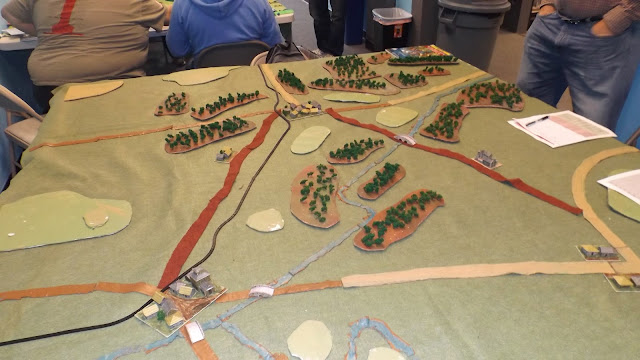I ran the fictional early war scenario "The Battle of Rabid Rabbits Rapids" at Peanut Wars this past weekend using From Manassas to Appomattox by Hoplite Research. Both sides had equal forces of six infantry divisions, two cavalry divisions, and six battalions of 6 pound smooth bore cannons. The union army was organized as two equal sized corps of three infantry divisions, one cavalry division, and three artillery battalions. The union elected to keep all their artillery batteries under corps command instead of assigning them to each division. The confederate army had the two cavalry divisions under one corps commander and the infantry divisions under the other corps commander. Each of the infantry divisions had one of the artillery battalions assigned to it. Each infantry and cavalry division had eight stands. Game scale was one inch = 100 yards, each infantry stand = 500 men, each artillery stand = 12 guns, and each cavalry stand = 300 men. For smaller battles there is an alternative game scale where one inch = 50 yards and formations are brigades instead of divisions.
Greg surveys the battlefield. Both sides had to designate which of the two roads on their table edge their troops would enter on
Another view of the battle field. Objectives were control of the two towns with the railroad and/or driving the opposing army from the battle field.
The first turn. Although units were designated to enter on a certain road there was the possibility of them entering one road to the right or one road to the left. This was to reflect the poor maps and order confusion that happened during a battle. One division from each union corps shifted one road to the right. On the confederate side one infantry division from each road shifted one road to the left.
The armies arrive on turn one. Some units were held up by units on the road ahead of them. The confederate infantry division at the edge of the table to the right of the cavalry is one of them and has not arrived yet.
Turn two. One of the union infantry divisions has deployed along the railroad tracks near the eastern town as the confederates advance towards it..
Western end of the battlefield as both sides deploy.
The infantry battle on the western end of the battlefield. Action at this end would be ferocious. The confederates would have the advantage in numbers with four infantry divisions and one cavalry division against three union infantry divisions. However, their troop quality would turn out to be not as good as the unions. All troops on both sides were treated as inexperienced and would have to roll to see what quality they were the first time that they would have to take a morale test or engage in melee. All union troops eventually tested as average. Except for the first infantry division on the right which was elite and the second infantry division on the left which was average, all other confederate divisions were poor.
The battle on the east end. The confederate first infantry division is on the left and the third infantry division is on the right.
The fighting on the west end. The union infantry division in the center was hit in its right flank and driven back facing its attackers. It was then hit in its right flank by another confederate infantry division and again driven back. About 1500 men from that division would be captured during that turn.
Action in the center and east. One confederate cavalry division has advanced through the woods near the confederate first infantry division.
The union cavalry decides to charge the confederate cavalry in the woods.
Manny Granillo's game of Ridiculous Vanity in the background. The union cavalry in the woods would take heavy losses, but would eventually chase the confederate cavalry away resulting in a popular song.
Action at the west end of the battlefield. Two union infantry divisions have been destroyed or routed. One of the two union cavalry divisions has moved to this flank as would the one of the two confederate cavalry divisions.
The fighting at the east end of the battlefield was not as intense as the fighting at the west end. The confederate first infantry division fought an inconclusive engagement with the union infantry while the other divisions fought over the town with the confederates gaining control of it. The confederate cavalry in the center can be seen running from the union cavalry after a failed charge against them. The union cavalry would later be heard singing the following (with apologies to Johnny Horton):
"Yeah, they ran through the briars and they ran through the brambles
And they ran through the bushes where a rabbit couldn't go.
They ran so fast that the hounds couldn't catch 'em
Down Rabid Rabbits Rapids as fast as they could go."
At this point the battle was called. The confederates won a close victory. Both sides held one town, but the union had suffered more casualties than the confederates and the confederates had captured three times as many prisoners as the union had (1500 to 500).















No comments:
Post a Comment